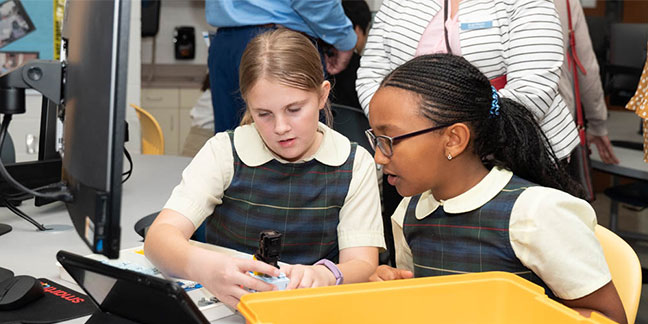Problem-solving with robots, drones and 3D printers
 CHARLOTTE — The top brass turned out at Our Lady of the Assumption School May 24 – and the students were ready.
CHARLOTTE — The top brass turned out at Our Lady of the Assumption School May 24 – and the students were ready.
It was time to cut the ribbon on a new $325,000 SmartLab filled with robots and drones, computers and iPads, 3D printers and a laser engraver.
These are learning tools educators could not have imagined a generation ago, part of a hands-on learning approach that teaches critical thinking, problem-solving and collaboration.
But before two eighth-graders could wield a giant pair of scissors to cut the red ribbon, the entire school – 180 students, pre-kindergarten through eighth grade – put on a show to welcome diocesan leaders May 24. Among them were Father Timothy Reid, vicar of education for Catholic Schools, and Dr. Greg Monroe, superintendent.
TV news turned out, too!
Standing at the lectern, in a gym adorned with multinational flags that illustrate the diversity of his students, Our Lady of Assumption Principal Tyler Kulp emceed the show.
“What types of things will we learn in the SmartLab?” he asked the students.
“Circuitry!” the pre-kindergartners called out.
“Robotics!” kindergartners shouted.
“Mechanics!” yelled the first-graders.
“Environmental technology…manufacturing technology…software engineering…media arts…recording data…control technology…scientific analysis,” students in each grade called out in turn.
Soon it was time to visit the main attraction.
The SmartLab is one of a handful across North Carolina, paid for through federal COVID-19 relief funds.
It’s a classroom with four “learning islands,” each equipped with three computers where two kids are assigned to work together on a project or problem. There are supplies of all kinds to help kids create. They’ll visit the SmartLab twice a week and follow a curriculum designed to take them through all the disciplines.
First-year teacher James Moore says in this classroom he will assist, not lecture. “My job,” he says, “is to direct and guide without giving them the answers. We want the kids to solve problems, to explore and figure it out on their own.”
At one learning island, pre-kindergartners Daniel and Cassidy used magic markers to draw lines thick enough for a golf ball-sized robot named “Ozobot” to follow on a sheet of paper. This was an intro to “coding.”
At another island, middle schoolers Anthony and Senai followed a computer model to build a bridge out of Lego-like composites.
Then there were eighth-graders John and Delila, who were working on a computer they said to “improve the design” of a flagpole holder their teacher produced on a 3D printer but didn’t work.
“This is very different learning than you do in a traditional class,” Leigh Robertson of SmartLab supplier Creative Learning Systems told students. “The problems you run into – it’s your job to solve those problems. It’s all on you. And you can do a lot of things you didn’t know you could do.”
Eighth-grader John Nguyen was inspired: “Man, I love this lab. There is so much to do and so much to experience. I want to be an engineer mainly because of this! I get to do this for a job!”
Even their principal couldn’t contain himself: “I can program this thing to follow me around the school,” Kulp said, holding a basketball-size robot on wheels.
Diocesan leaders congratulated the east Charlotte school for its example to others in the diocesan system of 20 schools.
“Catholic schools have always been on the forefront of cutting-edge educational teaching,” Monroe said.
“The more we learn about ourselves and our world, the closer we get to God.”
Father Reid, too, noted the kids’ great blessing and teased that they are “guinea pigs” trying out the SmartLab. “What a great blessing it is to have a SmartLab,” he told students. “It is your responsibility to take it very seriously and use it to the best of its potential and yours.”
— Liz Chandler. Photos by Troy Hull
















